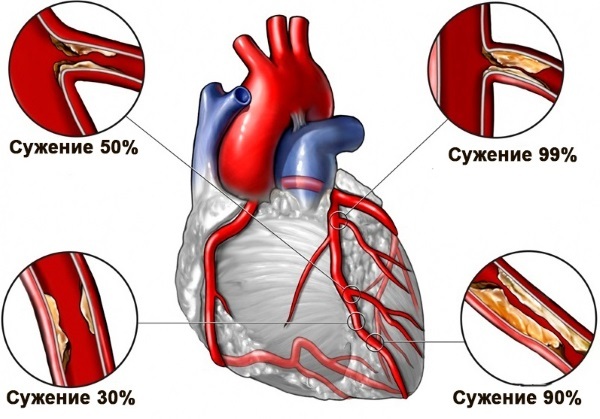Deceleration of intra-atrial conduction, found on the ECG, is due to organic lesions of the heart, in which there is a failure in conducting an electrical impulse through the muscle fibers of the atria.
Based on the degree of this disorder, the doctor makes a prognosis about the development and outcome of the underlying heart disease. Since the pathology is asymptomatic, an annual diagnostic examination is required for its timely detection.
Record content:
- 1 Electrophysiology of intra-atrial conduction deceleration
- 2 Classification and grades
-
3 The reasons for the slowdown in adults, children
- 3.1 A sharp rise in blood pressure
- 3.2 Inflammation of the heart muscle or myocarditis
- 3.3 Atherosclerosis of the coronary arteries or aorta
- 3.4 Heart attack
- 3.5 Extra-heart reasons
- 4 Symptoms
- 5 How does pathology affect the functioning of the body in adults and children?
- 6 How is pregnancy with atrial conduction disturbances going?
- 7 Which doctor should I go to?
- 8 ECG and other diagnostic methods
- 9 Correction methods and treatment: what and when to do?
- 10 Therapeutic measures
- 11 Surgical treatment
- 12 Sports for arrhythmias
- 13 Artimia video
Electrophysiology of intra-atrial conduction deceleration
The deceleration of intra-atrial conduction on the ECG is assessed by the state of the P wave, the duration of which should normally not exceed 0.11 s. This disorder may be due to left atrial hypertrophy or a failure in the conduction of impulses along the Bachmann bundle.

If a cleavage of the P wave appears on the cardiogram for more than 0.02 s, then the specialist predicts the possibility of in the near future, complete heart block, which is observed with myocardial infarction and ischemic disease.
Classification and grades
In medical practice, it is customary to distinguish between 3 degrees of deceleration, which are determined by the severity of the process:
- I degree - inhibition of electrical impulse conduction;
-
II degree - slowing down the conduction, alternating with single moments of blocking the passage of the impulse to the left atrium;
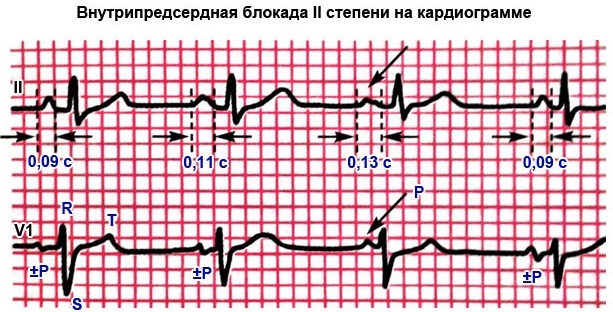
- III degree - persistent blockage of the passage of the impulse and the lack of communication between the work of both atria.
According to the persistence of the process, SGP are subdivided into chronic and transient.
The reasons for the slowdown in adults, children
The slowdown of intra-atrial conduction on the ECG appears due to the violation of the integrity of the cardiac conduction system, changes in its structure, or the intake of certain medications.
A sharp rise in blood pressure
With a sharp rise in blood pressure, an excessive tension of a separate part of the myocardium occurs, entailing a violation of the conduction of electrical impulses in the left and right atria. This is due to the simultaneous receipt of information from the brain about the contraction and relaxation of the heart muscle.
Despite the fact that this condition lasts tenths of a second, there is a cardinal violation of the blood supply to the organs.
Inflammation of the heart muscle or myocarditis
Organic causes of slowing of intra-atrial conduction include myocarditis caused by the following factors:
- infectious diseases of a viral, bacterial and fungal nature;
- autoimmune diseases;
- alcohol and cocaine consumption;
- taking certain medications.
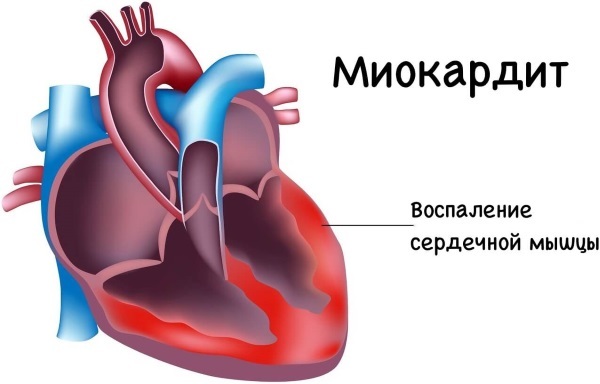
Myocarditis can cause slowing of intra-atrial conduction on the ECG.
With inflammation, the heart muscle ceases to fully perform its functions, as a result of which the conduction of electrical impulses is disrupted. Depending on the degree of damage, this condition can be reversible and irreversible.
Atherosclerosis of the coronary arteries or aorta
The formation of atherosclerotic plaques on the inner walls of the coronary vessels and the aorta leads to a loss of their elasticity, significant narrowing and complete closure of the lumen. In this case, the blood supply to the heart is disrupted, provoking a slowdown or violation of the conduction of electrical impulses.
Heart attack
The most common complication that occurs after myocardial infarction is impaired intra-atrial conduction of electrical impulses. This is due to the fact that the necrotic areas of the heart muscle in 30-60 days are completely replaced by scar tissue and irreversibly lose their function.
Extra-heart reasons
In some cases, slowing of intra-atrial conduction is normal and does not indicate the presence of malfunctioning of the myocardium or heart valves. This can occur after intense physical exertion or with a sharp increase in body temperature, when the amount of pumped blood per unit of time increases 2-3 times.
The slowdown in conduction, causing intoxication of the body, can be triggered by the abuse of strong alcohol or smoking a large number of cigarettes per day.
Symptoms
The slowdown of intra-atrial conduction on the ECG, manifested in an insignificant degree, is not reflected clinical picture on the patient's condition, not detected by auscultation, ultrasound of the heart and other internal organs.
With significant deviations from the norm of conductivity indicators in a person, the heart rate decreases to 50 beats per minute.
With such a pulse, the following is observed:
- slight pain in the chest area;
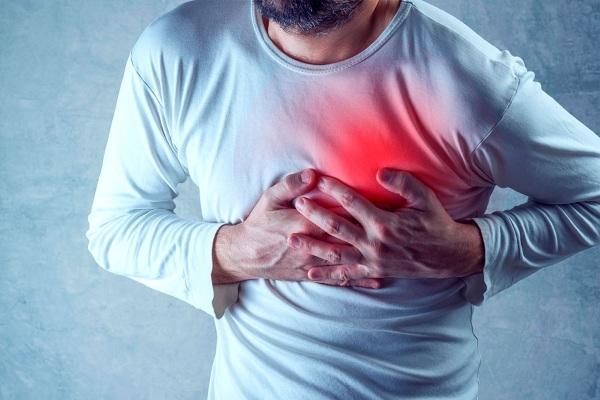
- excessive sweating;
- frequent dizziness;
- decreased visual acuity;
- sleepiness during the daytime and sleeplessness at night.
In children, similar symptoms are manifested in a more pronounced form. This is due to the lower blood volume and faster heart rate compared to adults.
How does pathology affect the functioning of the body in adults and children?
With a significant slowing down of intra-atrial patency, the normal flow of oxygen to organs and tissues is disrupted. And first of all, the brain suffers.
Therefore, patients may experience:
- attacks of shortness of breath without physical exertion;
- intoxication phenomena;
- violation of orientation in space;
- persistent headaches;
- loss of consciousness for a few seconds.
In the absence of therapy, this pathology entails the development of a violation of intraventricular conduction, in which several synoptic nodes are blocked. In this condition, part of the muscles in the human body stops contracting, leading to a sharp increase in internal pressure.
In children, physical and mental activity is sharply reduced, headaches and fatigue appear for no apparent reason.
How is pregnancy with atrial conduction disturbances going?
Pregnancy is not the cause of atrial conduction disturbances. However, there are factors that can provoke the development of this pathology.
These include:
- physiological changes in blood circulation (increase in total and stroke blood volume, acceleration of the heartbeat);
- increased sensitivity of adrenergic receptors, increased concentration of catecholamines;
- hormonal shifts, expressed in an increase in the production of progesterone, estrogen, prostaglandin and renin.
The combination of these processes contributes to a change in the excitability of the myocardium. If a woman had prerequisites for the development of pathologies of the cardiovascular system, then during gestation there is a high likelihood of developing a slowdown of the intra-atrial patency.
Doctors identify the following reasons that can provoke this violation:
- unbalanced physical activity;
- frequent or severe stress;
- the use of a large number of products that cause increased production of pyrocatecholamines (strong black and green tea, coffee, dark chocolate, nicotine);
- congenital heart defects;

- chronic diseases, neoplasms or previous trauma to the heart;
- pathologies of the respiratory system of various etiologies;
- systemic diseases;
- mental disorders;
- pathology of the central nervous system;
- a stomach or intestinal ulcer;
- chronic and acute hepatitis;
- malfunctions of the endocrine glands;
- imbalance of electrolytes in the body;
- poisoning.
In women with impaired intra-atrial conduction, gestosis, fetal malnutrition, and the birth of premature babies are often recorded.
Which doctor should I go to?
After detecting a slowdown in atrial conduction on the cardiogram, you should consult a cardiologist or arrhythmologist. After conducting a comprehensive diagnosis, they can additionally prescribe an examination by a neurosurgeon.
If changes in the work of the cardiac conduction system are caused by infectious diseases, then an infectious disease specialist should be consulted. Treatment of women during pregnancy should be coordinated with the leading gynecologist.
ECG and other diagnostic methods
Deceleration of intra-atrial conduction is detected by ECG, EPI or Holter monitoring. Standard electrocardiography is the mandatory and most affordable examination method used in all hospitals. It is based on the registration of bioelectric signals arising during heartbeats using graphic images.
Holter monitoring is an ECG that lasts from 24 hours to a week. This method makes it possible to record and track the bioelectric activity of the heart in everyday situations.

To conduct it, electrical impulse sensors are attached to the patient's body. The information read by them is displayed on the monitor screen and further interpreted by the cardiologist.
During the examination, the patient leads a normal life, including work, eating, physical activity, transportation, sleep and other routine activities.
A person must write down information about his physical and emotional state in a diary. It also provides data on food and drug intake, sleep duration and quality, and changes in well-being.
EFI (electrophysiological examination of the heart) refers to expensive methods carried out in a hospital setting.
There are 2 types of this examination that are used in the study of various pathologies.
In the first case, special catheters are installed in the veins of the patient's upper and lower extremities. Through them, electrodes are introduced, through which electrostimulation of the cardiac conduction system is carried out. In this way, it is possible to cause, eliminate and investigate the parameters of the arising conduction disturbances.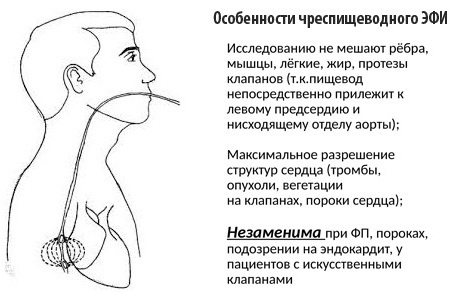
A simpler type of EPI is the transesophageal introduction of a probe-electrode, through which the left atrium is stimulated. This method allows you to study the most common types of deceleration of cardiac impulse conduction, and also accurately establish the sick sinus syndrome, common in the elderly.
Correction methods and treatment: what and when to do?
With slowing of intra-atrial patency, a unified treatment algorithm has not been developed. Initially, the true cause provoking this violation is revealed. If there are no concomitant diseases, then the patient is prescribed supportive therapy in the form vitamins, minerals, as well as drugs that improve tissue trophism and the transport of nutrients to them substances.
With hypertension, medications are used to stabilize the pressure. They are selected individually for each patient, depending on the age, the degree of deviation of the indicators from the norm, and the tolerance of specific medicinal substances.
In many cases, it is possible to reduce the incidence of attacks of slowing down intra-atrial patency with the help of:
- streamlining sleep patterns;
- correction of the diet;
- correct selection of physical activity;
- elimination of stress factors.
These measures are also effective in preventing cardiac disorders.
Therapeutic measures
The deceleration of intra-atrial conduction on the ECG, proceeding in an acute form, requires specific therapy.
| Groups of drugs | Drug names | Action taken |
| Anticholinergics | atropine, scopolamine, platifillin | Decreased tone of smooth muscles, improved conduction of electrical impulses in the heart. |
| Vasopressors | norepinephrine | Increased blood pressure |
| Glucocorticoids | hydrocartizone | Relief and removal of inflammation |
| Diuretics | lasix, furosemide | Removing excess potassium and fluid from the body. |
| Cardiac glycosides | cordigite, lantoside, adonis bromine | Elimination of arrhythmia, stimulation of the heart muscle. |
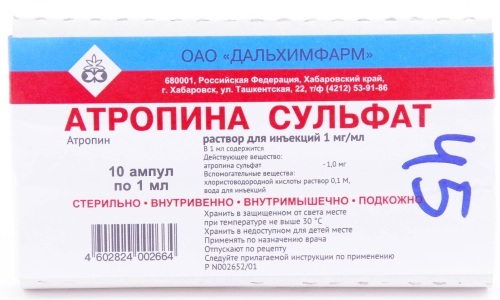
In some cases, the doctor decides on the appropriateness of the use of sedatives.
Pregnant women are prescribed magnesium supplements that do not adversely affect fetal development. The rest of the drugs aimed at improving intra-atrial conduction are used only for clinical indications when there is a threat to the mother's life.
Surgical treatment
With the ineffectiveness of conservative therapy, the following surgical methods are used:
- implantation of a pacemaker;
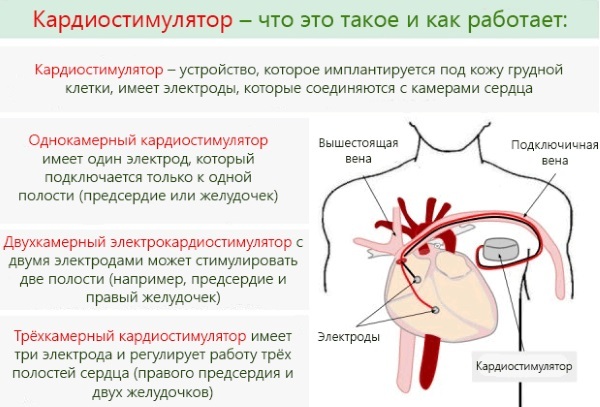
- replacement of heart valves with artificial analogues
Electrostimulator implantation has no age restrictions. In the future, the operated patients can lead a fulfilling life. They should only avoid exposure to strong electromagnetic waves, including undergoing magnetic resonance imaging.
People with built-in pacemakers should periodically visit a neurosurgeon and a cardiologist in order to check the health of the device and adjust the parameters of its settings.
This implantation is possible even during pregnancy. But, if there is no real threat to life, then up to 8 weeks, doctors recommend refraining from surgery. The installation of a pacemaker must be carried out under the control of an echocardiograph and using means that provide maximum protection for the fetus.
If the conduction disturbance is due to pathological changes in one of the heart valves, then the specialist suggests replacing it with a mechanical or biological artificial analogue. The choice is determined by a number of factors that the doctor evaluates after conducting numerous examinations and obtaining the results of laboratory tests of the patient's blood.
The mechanical heart valve is reliable and does not require replacement. However, after installing it, a person must constantly use drugs that reduce the level of blood clotting.
After a certain period of operation, biological valves begin to gradually deteriorate. Therefore, they are recommended to be installed for elderly people.
Sports for arrhythmias
Active sports are contraindicated for people suffering from a slowdown in atrial patency. In the case when it is complicated by ischemic arrhythmia, any physical and emotional stress becomes strictly contraindicated, as it can provoke a pre-infarction state.
Sudden arrhythmia death syndrome occurs even in very young athletes. In most cases, this syndrome develops against the background of a previously undetected lesion of the cardiac conduction system.
Currently, scientists are paying special attention to the study of arrhythmias in children. This is due to the specificity of the development of arrhythmia at a young age, which, in the presence of increased physical activity, can provoke pathophysiological changes in the cardiovascular system, and in severe cases, lead to fatal the outcome.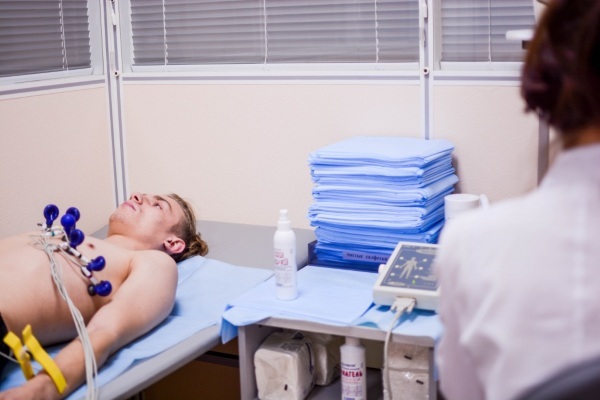
The optimal solution for slowing intra-atrial conduction detected on an ECG is to regularly perform a complex of exercise therapy, developed by a specialist doctor. Properly selected exercise therapy exercises increase the effectiveness of treatment, reduce the rehabilitation period and prevent the subsequent development of pathology.
However, self-study, performed without prior consultation with a doctor or instructor, can have the opposite effect and lead to a deterioration in the patient's condition.
Artimia video
Violation of the rhythm and conduction of the heart:



